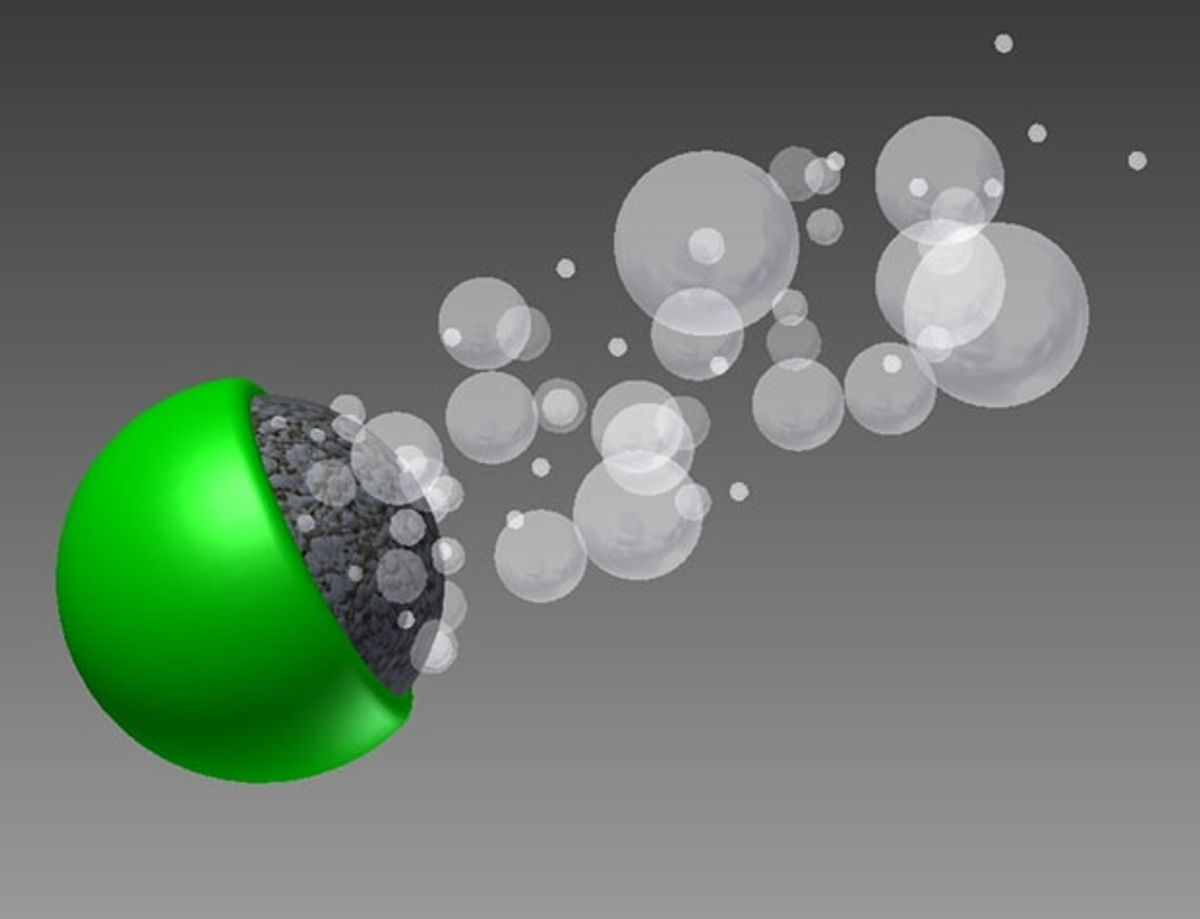Chemistry teachers with a flair for the dramatic sometimes throw pure sodium into a body of water, causing a reaction that blows the sodium back out of the water and blows their students’ minds. Engineer Wei Gao, at the University of California, San Diego, thinks smaller. He envisions a controlled version of that reaction so small it would fit on one side of a 20-micrometer particle.
For particles that size, ordinary water is as viscous as tar is to us (see the classic lecture “Life at Low Reynolds Number,” [PDF] by Edward Purcell). One way to push through it is to use the fluid itself as fuel. In 2011, Gao and his colleagues dropped microscopic zinc particles into hydrochloric acid. The results weren’t explosive, but the researchers clocked their zinc particles scooting at 1050 μm per second, or around 100 body lengths per second. To simulate that, a 2-meter-tall human would need to swim through four tar-filled Olympic swimming pools in 1 second.
Gao’s propulsion system is great for delivering tiny payloads to a place like the stomach, which is also very acidic, but it isn’t so useful elsewhere in the body, where conditions are more benign. Such an ability would be useful, as researchers are interested in developing microrobots that deliver medical payloads precisely to their targets (see “Magnetic Microbots to Fight Cancer,” IEEE Spectrum, October 2012). Future particle-bots could deliver drugs, perform small surgeries, or repair damaged tissue.
To accomplish this, Gao’s team turned to something that would react with water: aluminum. They built what are known as Janus particles, named for the two-faced Roman god; the particles have a stable titanium face and a reactive aluminum side. In water, the aluminum created hydrogen gas bubbles, which pushed the particles at up to 150 body lengths per second, the team reported in ACS Nano last year. Gao presented the combined zinc and aluminum results on 10 April at the American Chemical Society spring meeting in New Orleans.
But the motors don’t last long—2 minutes in the case of the zinc particle. In Gao’s first experiments, the aluminum side of the particles accumulated an oxide, limiting the motor’s life. Adding gallium to the mix improved its performance up to 5 minutes. He says the team may add indium or tin in future experiments because, like gallium, they help remove the oxidation layer as it forms.
As for steering, Gao suggests that a weak magnetic field, applied from outside the body, could guide magnetized particles to a target. Materials scientist Samuel Sanchez, of the Leibniz Institute for Solid State and Materials Research, in Dresden, Germany, has built magnetically steered Janus particles from platinum and cobalt, but they relied on toxic hydrogen peroxide as their medium and source of fuel. Hydrogen peroxide is popular among nanoresearchers for its energy density. Sanchez, who is not part of Gao’s group, says that “getting rid of hydrogen peroxide as a fuel is very nice.”
Physicist Peer Fischer at the Max Planck Institute for Intelligent Systems, in Stuttgart, Germany, calls the ability to draw on the local medium for fuel “beautiful” but notes that for some applications, steering will be essential. His group works on magnetically propelled particles. That requires a stronger field than just steering, but “you still need a magnetic field at the end of the day,” he says. “So why not combine these things?”
Fischer is also skeptical about chemically powered nanoparticles as drug-delivery vehicles. He’s says he’s more excited by the potential to deliver genetic material to a cell nucleus or to conduct microsurgery with tools that are less than 1 percent the size of a surgical needle. Sanchez adds that fast-moving nanoparticles could help with environmental remediation, such as water purification. That may be more useful, if less exciting to students, than chemicals that explode on contact with water.
About the Author
Based in Madrid, Lucas Laursen writes about a variety of technologies—especially technologies that turn animals or plants into fuel cells. Recently, he’s been covering human-robot interactions for IEEE Spectrum. We think maybe he had a bad run-in with BigDog.
